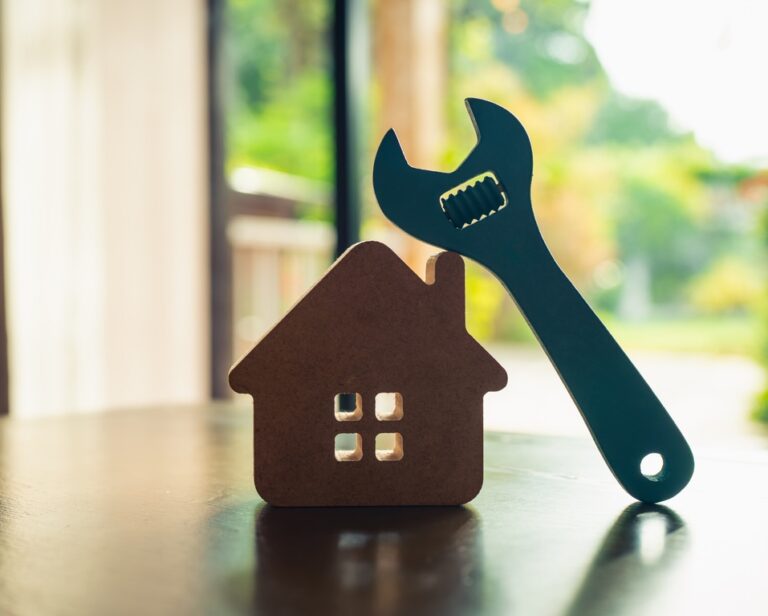Key Takeaways:
- Regular home maintenance can protect and even enhance your home’s value.
- Simple annual and seasonal checks of systems and devices around your home will go a long way in preventing big problems – and big expenses – down the road.
- Home equity can be an excellent source of funds for major maintenance and repair projects.
Homeownership offers many rewards—pride, stability, and the chance to build equity—but it also carries the responsibility of regular maintenance.
While it can be easy to delay or ignore preventive maintenance, taking proactive measures will help you avoid expensive repairs down the road. In addition, you’ll reduce safety risks, extend the life of your systems, improve energy efficiency, and preserve – or increase – your home’s long-term value.
In this guide, we’ll review how to maintain home systems, offer home maintenance tips, and look at options to pay for any needed work.
Gutter system
Your gutter system plays an important role in maintaining your home, helping to divert water away from the property to prevent it from collecting under your roof shingles, or gathering around your foundation.
Gutters have several components, and it’s important to take care of each part. Clean your gutters regularly and check for cracks, peeling paint or rust, which may mean it’s time to replace them.
Downspouts are the portion of the gutter system that runs vertically and delivers water down the side of the home. At least once a year, check to see if the downspouts are carrying water at least five feet away from the house, and that the water coming out of them does not flow backward toward the house. If needed, you can easily install gutter extensions to address the issue.
Electrical system
While there are no overall preventive maintenance tips for electrical systems, it’s important to keep an eye on how your system is running. Replace any outlets that don’t work, breakers that trip frequently or lights that flicker. Any of these could be a sign that you are overtaxing your electrical system or have a loose wire or failing wiring system. Acting quickly on these relatively minor issues can help you avoid major repairs.
Foundations and flat work
- Foundations. Make sure all water is draining away from your foundation walls (the concrete that shows at the bottom of exterior walls of the house) and the house itself. To do this, install gutter extensions, and make sure the soil slopes away from the house so that water flows away from the foundation. Keep an eye on tree roots from large trees in your yard. They can start to push on foundation walls, showing up as cracks in the walls.
- Flat work. Flat work refers to all the horizontal concrete around your home, like driveways, sidewalks, patios and your garage floor. Taking care of minor issues when they appear is far less expensive than having to tear out and replace entire areas of concrete.
Inspect regularly for cracks and movement (sloping or breaks). If you detect movement, investigate mudjacking and confirm that your gutters are placed properly. If you see cracking, fill with sealer.
If you are in an area where it snows, clear snow from concrete as soon as possible. Leaving it can cause surfaces to crack and erode. Ice buildup can destroy the surface of concrete.
HVAC
By heeding these heating, ventilation, air conditioning maintenance tips, you’ll prevent costly home repairs.
- Heater. Check filters monthly and replace them as needed, which could be monthly if you are heating or cooling often. It’s a good idea to get a professional furnace inspection every two years. This practice can help ensure that the fan inside the unit – which blows hot air – is clean and free of residue.
If you live in an older home with radiators, you may want to obtain an annual professional inspection. In addition, check monthly for cold spots on top of the radiator. If you find any, bleed the air from the radiator using a radiator key.
- Central air conditioning. Consider a professional inspection and cleaning of the outdoor unit every five years.
- Window air conditioner. Clean your air filter or replace it when needed, and store your unit in the winter if possible.
- Swamp cooler. Each fall, you’ll need to drain and cover it. Each spring, you’ll need to determine if the swamp cooler’s pads need replacement, clean out any debris, and make sure the fan runs and water flows. Professional HVAC experts, as well as many handymen, can handle these tasks.
Roofing
The type of roofing maintenance you need to do depends on the type of roof you have. For example, cement tile and metal roofs need no maintenance. The following are suggestions for different roof materials. For all types of roofs, remove leaves and other plant debris so that rain and snow run off.
- Asphalt shingles. Asphalt shingles are by far the most common roofing material in the United States. All roofs are rated in the number of years they can expect to last. To get the most life from your roof, take these preventive roof and gutter maintenance steps.
What not to do: climb up on a ladder to take a look at your roof. Instead, inspect the ends of your downspouts for piles of very small pebbles. If you see many of them, there’s a good chance the roof is wearing and may need to be replaced. At that point, contact a roofing expert for an inspection. - Cedar shingles. If you live in a dry climate, once a year, get your binoculars out, and scan for splitting and cracking in the shingles. If you live in a wet climate, look for a buildup of moss. It really is important to use binoculars and do on-the-ground checks. These shingles can break easily with the weight of a step, and if mossy, it’s very easy to slip and fall.
If you see any broken shingles, employ a professional to replace them. If you find moss, you’ll need a professional to pressure wash and apply a chemical retardant to the shingles. - Cement tile and metal roofs. These roofs need no maintenance.
- Eaves, which are the edges of the roof that hang past the walls of your home, are another part of your roofing system that requires annual maintenance. Inspect your eaves for damage and check your vents to be sure they are clear of debris. If the eaves are made of wood, you may need to repaint them or stain them every so often and trim trees that may be hanging over the eaves.
Plumbing
- Sump pump. Many homes with basements have sump pumps, which take water away from the foundation of a house. The pump works via a perimeter drain around the outside of the house directing excess water into a pit in the basement. When that pit starts to get full, the pump ejects the water away from the house. If the sump pump stops working, or does not work properly, the basement can flood quickly.
Before the season(s) that are particularly rainy in your area, look into the sump pit. If there’s water above the pump, it’s not working. If there is no water above the pump, you can run a few buckets of water (or hose) into it and see if it fires up. - Sewer pipe. Unless you live in a home with a septic system, you will have a sewer pipe that carries wastewater from the house to your municipality’s sewer pipe. It’s a good idea to employ a plumber to scope the pipe every 5 to 10 years. Scoping will identify any breaks, dips, or tree roots in the pipe.
- Stops and valves. Every two years, go through your house and make sure that all of the stops, or valves, on every sink and toilet actually turn the water off. Do the same for the main valve to the house (often located in a basement, crawl space or mechanical room).
Water heater
Water heater maintenance on traditional water heaters is simple, involving an annual test of a valve.
Every heater has a temperature and pressure-relief valve that serves as a safety device. Because heat expands, temperatures inside the water tank can become very high. When too high, the valve will automatically open to prevent the water heater from exploding. It closes when the temperature and/or pressure return to a safe level.
Once a year, homeowners should check to make sure the valve can and does open. The best thing to do is to watch one of many available short online how-to videos on the topic.
No matter how carefully you maintain your valve, the typical life of a water heater is 12-15 years. Around that time, you’ll notice that you are just not getting hot water like you used to, and you’ll need a replacement.
How to pay for your home maintenance and repairs
Preventive maintenance can help you avoid many repairs. Plus, HEA holders are required to keep their homes well-maintained or run the risk of facing a maintenance adjustment when they exit their agreement. But repair and maintenance work can be expensive and stressful. To pay for home maintenance and repairs, homeowners have several options.
- Savings. Many experts recommend saving 1% to 3% of your home’s value each year to pay for home maintenance and repairs. Ideally, you will plan ahead, If you have an older home or one with complex features, or live in a harsher climate, you may need to budget more.
- Personal loan. Banks, credit unions and independent lenders offer personal loans. With these loans (often available up to $50,000), you’ll repay the amount borrowed, plus interest, over a set period. Most lenders charge origination fees of up to 9% of the amount borrowed.
- Home equity loan (HEL) or home equity line of credit (HELOC). Using home equity can be a good option for many homeowners to fund maintenance and repairs. Both an HEL and a HELOC are loans. With an HEL, you’ll receive the total amount you borrow up front. HELs come with fixed interest rates, so your monthly payments will remain the same over the life of the loan. In contrast, a HELOC lets you draw money as you need, up to the limit the lender has set for you. The interest rate is usually variable, although some fixed-rate HELOCs are available. You’ll pay interest on the amount drawn. Both of these loans use your home as collateral. If you miss payments, you risk foreclosure and losing your home.
- Home equity agreement (HEA). An HEA can be a potential funding source for major upkeep or replacement costs. With an HEA, you’ll receive cash up front in exchange for a portion of the future value of your home. With Unlock, you can settle, you HEA any time during its 10-year agreement term.
Creating a home maintenance checklist
Every home is different. Based on the features in your home, your individual living patterns and location, you can use these home maintenance tips to put together a simple home maintenance checklist. That way, you’ll be taking necessary steps to avoid many costly – and time-consuming – repairs.
By maintaining your home, you’ll extend the life of its systems and devices, increase energy efficiency, and save money in the long run.



